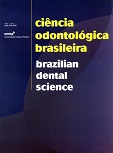Efetividade de quatro solventes sobre diferentes cimentos endodônticos
DOI:
https://doi.org/10.14295/bds.2009.v12i2.350Abstract
Este estudo teve como objetivo avaliar a capacidade solvente de quatro solventes sobre cimentos obturadores. Os cimentos avaliados foram: Acroseal, AH Plus, Epiphany, Endomethasone N e Sealer 26. Foram confeccionados corpos-de-prova circulares com 10 mm de diâmetro e 1 mm de espessura para cada cimento. Cada corpo-de-prova foi pesado em balança de precisão até a estabilização da massa, quando a massa inicial foi determinada. Em seguida, os corpos-de-prova (n=07) foram imersos por 10 minutos nas soluções solventes avaliadas: eucaliptol, óleo de laranja (citrol), xilol e uma solução solvente experimental à base de tetracloroetileno. Depois de 48 h em estufa a 37ºC, foram realizadas novas pesagens a cada 24 h, até a estabilização (massa final). A diferença da massa final e inicial determinou a capacidade solvente. Os dados obtidos foram submetidos à análise de variância com 5% de significância e teste de Tukey. O cimento Endomethasone N foi o material mais solubilizado pelos solventes estudados. O cimento que apresentou menor solubilização foi o AH Plus, seguido pelo Acroseal, exceto no grupo eucaliptol, onde o Sealer 26 apresentou maior solubilização que o Acroseal. O cimento Epiphany, embora com baixa solubilização, foi o que apresentou maior ação solvente após o Endomethasone N. Conclui-se que o cimento à base de óxido de zinco e eugenol é o mais solubilizado pelos solventes avaliados, destacando-se o xilol.
Downloads
Downloads
Published
How to Cite
Issue
Section
License
Brazilian Dental Science uses the Creative Commons (CC-BY 4.0) license, thus preserving the integrity of articles in an open access environment. The journal allows the author to retain publishing rights without restrictions.
=================




























